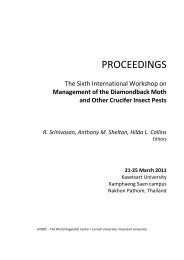Leguminous Vegetable Cultivation and Seed Production S ...
Leguminous Vegetable Cultivation and Seed Production S ...
Leguminous Vegetable Cultivation and Seed Production S ...
You also want an ePaper? Increase the reach of your titles
YUMPU automatically turns print PDFs into web optimized ePapers that Google loves.
No-Tillage Rice Stubble Soybean <strong>Cultivation</strong> (NTRSC)<br />
Many farmers in southern Taiwan have been growing soybean after harvesting rice,<br />
without tilling the l<strong>and</strong>. After producing two rice crops, the farmers are able to grow a third crop of<br />
soybean in the same field. They use minimum resources <strong>and</strong> earn a reasonable income. This<br />
practice can be easily adopted in other tropical countries where rice-based cropping systems<br />
predominate.<br />
The no-tillage approach for growing soybean after rice with limited resources produce a<br />
high-value soybean crop with low inputs within a short growing season.<br />
Soybean cultivation practiced by farmers in southern Taiwan is presented in the following:<br />
• The no-tillage rice stubble soybean cultivation or N-T-R-S-C can be practiced in a rice-based<br />
cropping system wherever rice is a major crop.<br />
• The farmers in southern Taiwan grow two rice crops from January to September <strong>and</strong> a third crop<br />
of short duration early maturing soybean from September to December just after harvesting rice<br />
without l<strong>and</strong> tillage.<br />
• After the rice crop is harvested <strong>and</strong> threshed, the rice straw is bundled <strong>and</strong> kept in the rows.<br />
e The rice stubbles left after the harvest serve as markers of planting rows for soybean.<br />
• To plant soybean, either a planter is used or a group of men <strong>and</strong> women are employed for<br />
planting. A bag containing soybean seed is worn around the waist <strong>and</strong> each person plants about 5<br />
rows at a time. Each individtial plants about 1,000 M2 in one day.<br />
e With the help of a small trowel, a shallow hole (3 to 4 centimeters deep) is made near each rice<br />
stubble <strong>and</strong> 3-4 seeds are dropped in each hole. The hole is not covered.<br />
• The spacing between <strong>and</strong> within the row is the same as that for rice, either 22.5 cm by 22.5 cm<br />
or 25 cm by 25 cm.<br />
• Just after planting, a herbicide mixture of alachior at the rate of 1.5-2 kilograms active ingredient<br />
(al.) per hectare plus paraquat 0.75 kg a.i./ha is applied to control weeds.<br />
• The rice straw is then spread on the field. The straw should not be allowed to hang on to the<br />
stubble to prevent shading which could result in lanky <strong>and</strong> weak seedlings.<br />
• A paddy row marker is used as a roller to press the rice straw close to the ground. The rice straw<br />
mulch conserves moisture <strong>and</strong> suppresses weed growth.<br />
• In some low-lying areas, the straw is burnt after spreading. Burning of the straw reduces excess<br />
moisture, destroys the weeds, kills some insect pests <strong>and</strong> their eggs <strong>and</strong> adds potash to the soil.<br />
e Reduction of soil moisture loosens the soil making it friable, <strong>and</strong> providing optimum conditions<br />
for seed germination.<br />
• The seedlings emerge easily from the straw mulch.<br />
• A fertilizer mixture containing 20 to 30 kg N + 60 kg P205 + 80 kg K20/ha is prepared <strong>and</strong><br />
broadcasted on the mulched field. Or, it may be applied just after burning the straw. In the burnt<br />
field, the quantity of potash is reduced to 50-60 kg/ha.<br />
• You can see the excellent germination in fields with rice straw mulch or on a burnt field.<br />
8
















